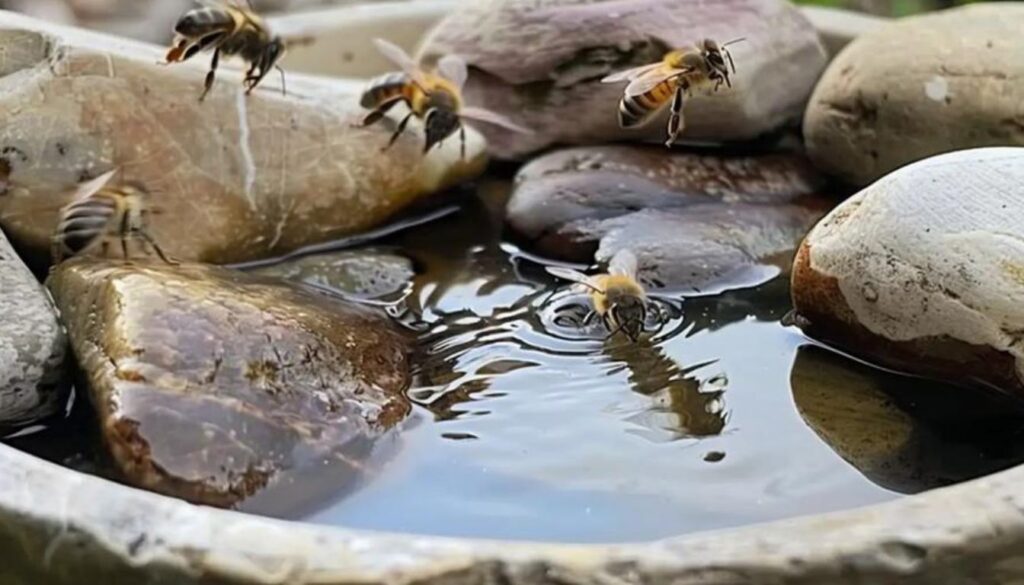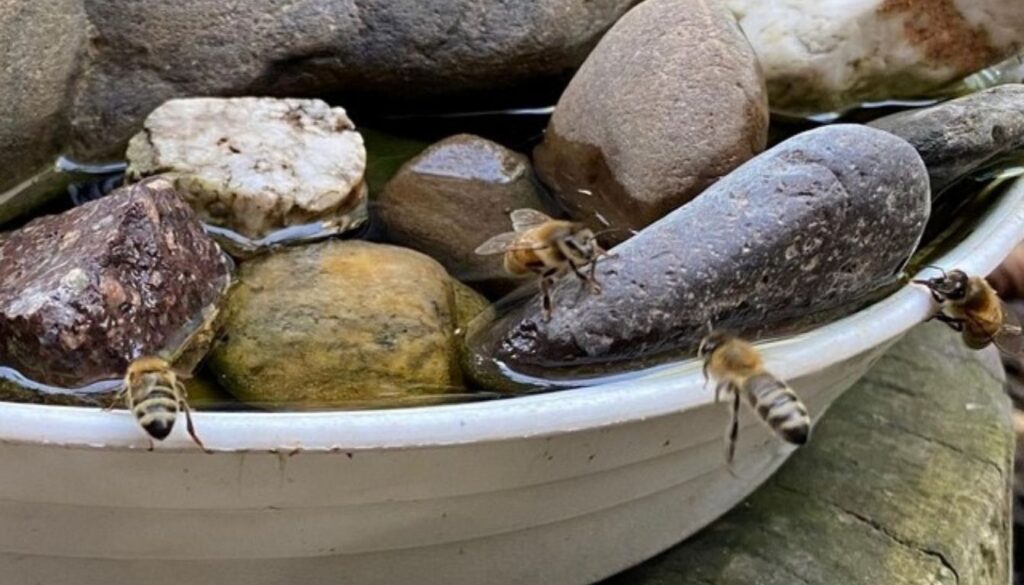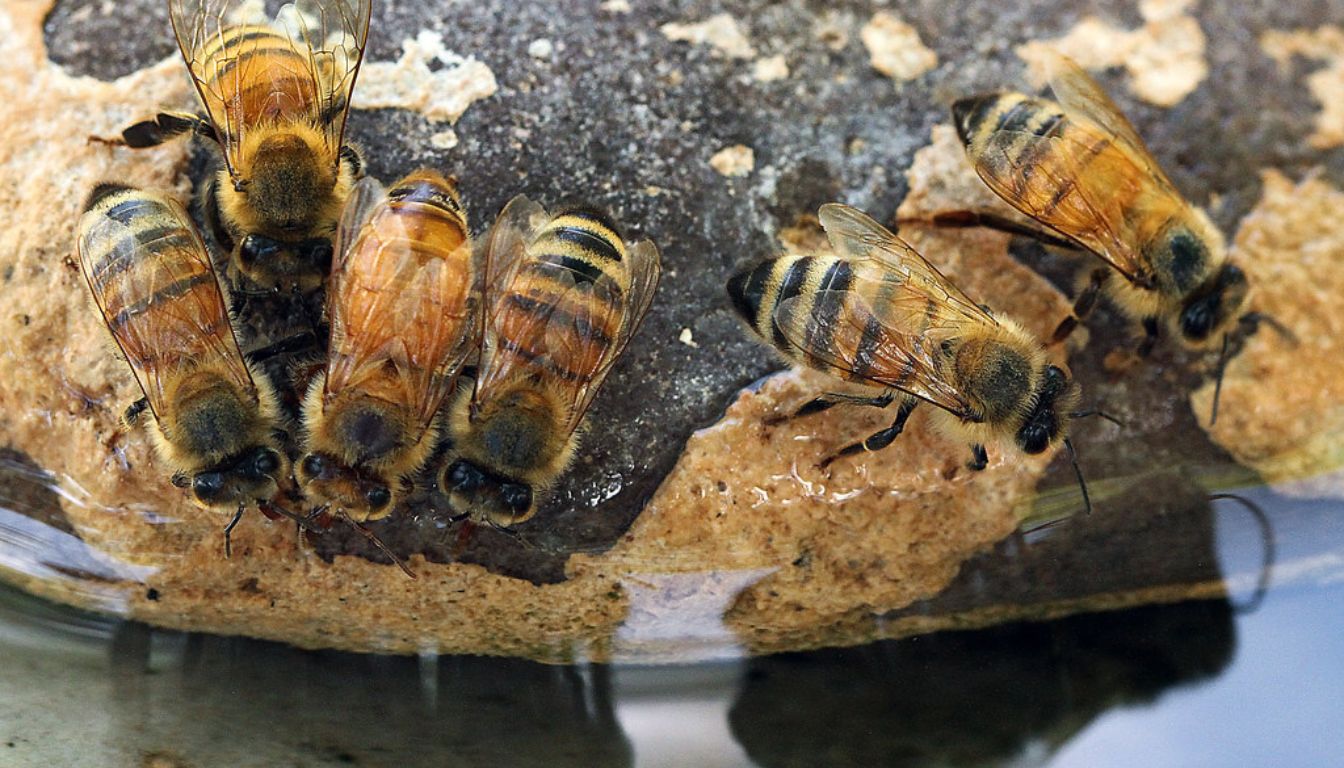As a beekeeper, I understand the importance of providing bees with a reliable water source. Bees need water to regulate hive temperature and dilute honey. However, clean water isn’t always accessible. This is where a bee water dish becomes essential for our pollinator friends.
A bee water dish is a simple and effective way to provide bees with a source of clean water. It can be as simple as a shallow dish filled with water and placed in a shady spot in the garden. The dish should have a rough surface or floating objects, such as marbles or twigs, to provide bees with a safe place to land and drink without drowning. It is important to keep the water clean and free of debris, so it should be changed regularly.
Creating a bee water dish not only helps the bees, but it also benefits the garden. Bees are essential pollinators for many plants, and providing them with a water source can help improve their health and increase their presence in the garden. In addition, a bee water dish can help deter bees from seeking out less desirable water sources, such as swimming pools or bird baths treated with chemicals. Overall, a bee water dish is a simple and effective way to support the health and well-being of our pollinator friends while also benefiting the garden.
Importance of Water for Bees
As a beekeeper, I know that water is one of the most essential components for the survival of bees. Bees require water for various reasons, including hydration, temperature regulation, diluting honey stores, and maintaining hive humidity levels.
Hydration and Cooling
Bees need water for hydration, especially during hot weather when they need to cool their hives. Bees use water to create air conditioning within their hives by fanning their wings over water droplets, which then evaporate and cool the hive. Without a source of water, bees can become dehydrated and unable to regulate the temperature of their hive, which can lead to colony collapse.
Diluting Honey
Bees also use water to dilute honey stores. Bees collect nectar from flowers and bring it back to the hive, where they convert it into honey. However, the nectar is too concentrated to store as honey, so bees mix it with water to dilute it to the proper consistency. Without water, bees cannot dilute the honey, and the colony may run out of food.
Nursing Baby Bees
Water is also crucial for nursing baby bees. Bees create a special food called “bee bread” to feed their larvae, which is made from pollen, honey, and glandular secretions. However, the bee bread needs to be moist to be fed to the baby bees. Bees use water to moisten the bee bread and ensure that the larvae receive proper nutrition. Without water, the larvae may not receive enough food and may not develop properly.
Water is an essential component for the survival and well-being of bees. As a beekeeper, it is important to provide a consistent source of clean water for your bees. This can be done by setting up a water dish, providing a dripping hose or faucet, or creating a small pond or fountain. By providing bees with access to clean and reliable water sources, we can help support their overall health and contribute to the sustainability of bee populations.
Designing a Bee Water Dish
As a beekeeper, I understand the importance of providing water sources for bees. Bees need water to hydrate themselves and regulate the temperature inside their hives. A bee water dish is an easy and inexpensive way to provide water to bees. In this section, I will share some tips on designing a bee water dish.
Choosing the Right Container
When choosing a container for a bee water dish, it is important to choose a shallow dish that is no more than two inches deep. Bees can drown in deep water, so it is essential to provide a shallow water source. The container should also be wide enough to allow multiple bees to drink at the same time.
Some of the containers that can be used as a bee water dish are:
- Saucers
- Plant pot saucers
- Pie tins
- Plastic lids
- Glass bowls
Making It Bee-Friendly
To make the bee water dish more bee-friendly, it is important to provide landing spots for bees. Bees need a place to land while they drink water. Pebbles, corks, and stones can be placed in the dish to provide landing spots for bees.
Adding some colorful glass pebbles to the water dish can also make it more attractive to bees. Bees are attracted to bright colors, and the colorful pebbles can help them locate the water source.
Preventing Drowning
One of the biggest concerns when providing water to bees is the risk of drowning. Bees can easily drown in deep water or water that is too cold. To prevent drowning, it is important to keep the water level low and change the water frequently.
Adding a few drops of vinegar or lemon juice to the water can also help prevent the growth of bacteria and algae, which can make the water toxic to bees.
Designing a bee water dish is a simple and effective way to provide water to bees. By choosing the right container, making it bee-friendly, and preventing drowning, we can help ensure that bees have access to the water they need to thrive.
Placement of Bee Water Dishes
As a beekeeper, I know how important it is to provide a safe water source for bees. But it’s not just about putting out any old dish of water. Proper placement of bee water dishes is crucial to ensure that bees can access the water they need without being exposed to predators or pests.
Ideal Locations
When choosing a location for your bee water dish, consider the following:
- Near the hive: Bees are more likely to use a water source that is close to their hive. Placing the dish within 100 feet of the hive is ideal.
- Shaded: Bees prefer water that is not in direct sunlight. Place the dish in a shaded area to keep the water cool and prevent evaporation.
- Flat surface: Bees need a flat surface to land on when drinking water. Make sure the dish is not too deep and has a shallow landing area.
- Stable: Bees need a stable surface to land on when drinking water. Make sure the dish is not too wobbly and can withstand wind and other weather conditions.
Avoiding Predators and Pests
Ants and wasps are common pests that can be attracted to bee water dishes. Here are some tips to keep them away:
- Elevate the dish: Placing the dish on a pedestal or other elevated surface can help keep ants and other crawling insects away.
- Add vinegar: Adding a small amount of vinegar to the water can help repel ants and wasps.
- Clean the dish regularly: Be sure to clean the dish regularly to prevent the growth of algae and other organisms that can attract pests.
By following these guidelines, you can help ensure that your bee water dish is a safe and effective source of water for your bees.
Maintenance of Bee Watering Stations

As a beekeeper, I know that maintaining bee watering stations is crucial for the health and well-being of our buzzing friends. Here are some tips on how to keep your bee watering station in top condition.
Regular Cleaning
Keeping the bee watering station clean is essential to prevent the growth of harmful bacteria and parasites. I recommend cleaning the bee watering station at least once a week. First, remove any debris or dead insects from the water. Then, use a mild soap and warm water to clean the container thoroughly. Rinse the container with clean water, and refill it with fresh water.
Changing Water
Bees need clean water to stay healthy, so it is important to change the water in the bee watering station regularly. I suggest changing the water every two to three days, especially during hot weather when the water can evaporate quickly. If you notice any algae or discoloration in the water, it is time to change it immediately.
Seasonal Adjustments
During the summer months, bees need more water to stay hydrated. Make sure to fill the bee watering station with enough water to last through the day. During the winter months, it is important to check the bee watering station regularly to ensure that the water does not freeze. If the water freezes, replace it with fresh water.
Maintaining a bee watering station is essential for the health and well-being of our buzzing friends. By following these simple tips, you can ensure that your bee watering station is clean, fresh, and ready to provide bees with the water they need.
Attracting Bees to Water Sources
As a beekeeper, I know how important it is to provide bees with a reliable source of water. Without water, bees cannot produce honey, and they may resort to drinking from less-than-ideal sources like swimming pools or bird baths. In this section, I will discuss how to attract bees to water sources using natural attractants and creating a safe environment.
Using Natural Attractants – Bee Water Dish
Bees are attracted to flowers, nectar, pollen, and scent. By planting flowers and herbs like lavender, mint, and thyme near your water source, you can create a natural attractant for bees. Additionally, adding a few drops of lemongrass oil to your water source can help attract bees to the area. Bees are also attracted to water that smells like wet earth, moss, aquatic plants, worms, decomposition, or even chlorine.
Creating a Safe Environment
When creating a water source for bees, it’s important to keep safety in mind. Bees need a safe place to land and drink without drowning. Using rocks, stones, pebbles, gravel, marbles, sticks, and corks can provide a safe harbor for bees to access the water without slipping in. Additionally, you can turn a bird bath into a bee watering station by adding marbles, rocks, or crystals for safe landing perches. Avoid using insecticides or chemicals near your water source, as these can harm bees.
By using natural attractants and creating a safe environment, you can attract bees to your water source and provide them with a reliable source of hydration. Not only will this benefit your bees, but it will also benefit your garden by providing pollinators for your flowers and vegetables.
Protecting Bees from Harmful Substances – Bee Water Dish
As a beekeeper, I know how important it is to provide bees with a safe environment where they can thrive and flourish. One of the ways we can protect our bees is by providing them with a clean and safe source of water. In this section, I will discuss some of the ways we can protect our bees from harmful substances when providing them with water.
Avoiding Chemicals – Bee Water Dish
Chemicals such as chlorine can be harmful to bees. It is important to avoid using any chemicals when providing water to bees. If you are using tap water, let it sit out for a few hours before putting it in the bee water dish. This will allow the chlorine to dissipate. Alternatively, you can use a water filtration system to remove any chemicals from the water.
Natural Water Sources
Providing bees with access to natural water sources is a great way to ensure that they are not exposed to harmful substances. Bees prefer water sources that are close to their hive, so consider placing a shallow dish of water near the hive. You can also create a small pond or water feature in your garden to provide bees with a natural water source.
Rainwater is another great source of water for bees. Consider placing a rain barrel near your bee hives to collect rainwater. This water is free from any chemicals and is a great source of hydration for your bees.
Providing bees with a clean and safe source of water is crucial to their health and well-being. By avoiding chemicals and providing natural water sources, we can protect our bees from harmful substances and help them thrive.
Before You Go – Bee Water Dish: Providing Essential Hydration

Bee water dishes are not only beneficial for bees, but they also provide additional benefits that support ecosystems and educational opportunities.
Supporting Ecosystems – Bee Water Dish
Bee water dishes can support a variety of pollinators, beneficial insects, and wildlife. Providing water sources for these creatures can help sustain their populations and promote biodiversity in your garden. By creating a bee-friendly garden, you can attract a wide range of pollinators and beneficial insects that can help control pests and improve your garden’s health.
Educational Opportunities
Bee water dishes can also be used as an educational tool for children and adults alike. By observing bees and other insects as they drink from the water dish, children can learn about the importance of pollinators and the role they play in our ecosystem. Additionally, bee water dishes can be used to raise awareness about the decline of bee populations and the need for conservation efforts.
Bee water dishes not only provide a safe and accessible water source for bees, but they also support ecosystems and provide educational opportunities for children and adults. By incorporating bee water dishes into your garden, you can help promote biodiversity and raise awareness about the importance of pollinators and conservation efforts.
Don’t forget to add theherbprof.com to your favourites so you don’t miss out on future articles!
References – Bee Water Dish: Providing Essential Hydration
Little Herb Encyclopedia, by Jack Ritchason; N.D., Woodland Publishing Incorporated, 1995
The Ultimate Healing System, Course Manual, Copyright 1985, Don Lepore
Planetary Herbology, Michael Tierra, C.A., N.D., Lotus Press, 1988
Handbook of Medicinal Herbs, by James A. Duke, Pub. CRP Second Edition 2007
The Complete Medicinal Herbal, by Penelope Ody, Published by Dorling Kindersley
Check the Following Articles!
Fast Growing Privacy Hedges: Best Options for Your Yard
Fresh Wood Chips for Mulch: Benefits and Usage Tips
Watering Mint Plants: Tips and Tricks for Optimal Growth
Frequently Asked Questions – Bee Water Dish: Providing Essential Hydration
How can I create a bee-friendly water dish at home?
Creating a bee-friendly water dish at home is easy and affordable. You can use a shallow dish or bowl and fill it with clean water. You can also add pebbles, marbles, or twigs to provide a landing pad for bees. Additionally, adding a few drops of lemongrass oil to the water can help attract bees to the dish.
What features make a water dish safe for bees?
A safe water dish for bees should be shallow, with a maximum depth of 2 inches. Bees cannot swim, so they need a surface to land on while they drink. Adding landing pads, such as pebbles or twigs, can provide a safe place for bees to rest while they drink. The water dish should also be kept clean and free of debris.
Where can I purchase a pre-made bee water dish?
Pre-made bee water dishes can be found at most garden centers or online retailers. However, it is easy and affordable to create your own bee water dish at home using a shallow dish or bowl and clean water.
What are the benefits of using a bee-drinking cup?
Bee drinking cups are a great alternative to traditional water dishes. They are designed to provide a safe and easy way for bees to drink water. They are also easy to clean and can be reused for many years. Additionally, bee drinking cups can be hung near flowers or plants to provide a convenient water source for bees.
How can I ensure bees don’t drown in my water dish?
To ensure bees don’t drown in your water dish, it is important to keep the water shallow and provide landing pads, such as pebbles or twigs. You can also add a few drops of dish soap to the water to reduce surface tension, which can help prevent bees from drowning.
Can the same water dish be used for both bees and butterflies?
While bees and butterflies both need water, it is best to provide separate water sources for each. Bees prefer shallow water dishes with landing pads, while butterflies prefer damp sand or mud. Providing separate water sources for each will help ensure that both bees and butterflies have access to the water they need.

